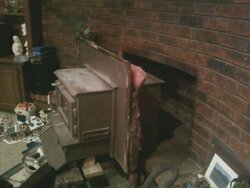Hi all,
Love your site. I have an Appalachian wood burner insert. It is probably a good 20 years old and it has given us reliable service. However, the color is a light gray and I want to change the color to black. Is powder coating the best way to change the color?
What started the idea of changing the color is we lit the first fire this year and the stove drew the smoke up the chimney but at the same time an acidic smoke would also slowly fill the room. It kind of burned your eyes. I would compare this smoke and odor to a new stove being lit for the first time and the paint and othe materials baking for the first time. But, we have been issuing this stove for years and never had this weird smoke fill the living room. So I pulled the stove out of the fireplace and made sure there was nothing behind it and I checked the flue for any problems. Both these inspections checked out and I could not find the source of this mystery smoke.
So, before I put the unit back in the fireplace I need to change the color if possible.
Thanks for any suggestions or advice.
Love your site. I have an Appalachian wood burner insert. It is probably a good 20 years old and it has given us reliable service. However, the color is a light gray and I want to change the color to black. Is powder coating the best way to change the color?
What started the idea of changing the color is we lit the first fire this year and the stove drew the smoke up the chimney but at the same time an acidic smoke would also slowly fill the room. It kind of burned your eyes. I would compare this smoke and odor to a new stove being lit for the first time and the paint and othe materials baking for the first time. But, we have been issuing this stove for years and never had this weird smoke fill the living room. So I pulled the stove out of the fireplace and made sure there was nothing behind it and I checked the flue for any problems. Both these inspections checked out and I could not find the source of this mystery smoke.
So, before I put the unit back in the fireplace I need to change the color if possible.
Thanks for any suggestions or advice.


